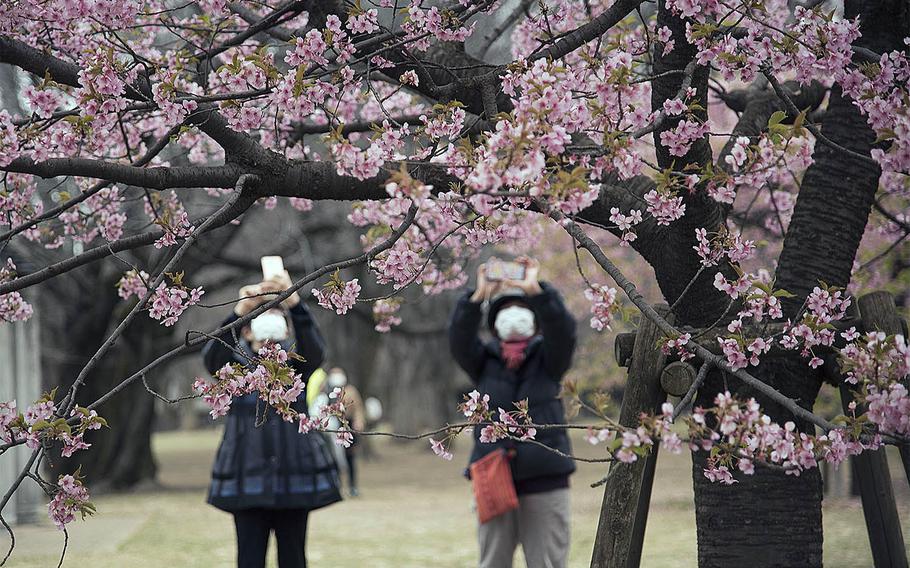
Yoyogi Park, seen here on Feb. 26, 2021, and other popular areas in central Tokyo are no longer off-limits to those stationed at Yokota Air Base, Japan. (Akifumi Ishikawa/Stars and Stripes)
TOKYO – The commander of Yokota Air Base on Tuesday lifted the coronavirus ban on off-duty travel to the most popular districts in Japan’s capital city and reduced the restricted movement period for vaccinated travelers.
Shibuya, Shinjuku and Roppongi, known for their crowded city streets, shopping, restaurants and nightlife, are open once again to people associated with Yokota, the headquarters in western Tokyo of U.S. Forces Japan, 5th Air Force and the 374th Airlift Wing. The order applies to anyone with access to the base, including service members, Defense Department civilian employees, family members and Japanese employees.
Yokota of all the U.S. installations in Japan had the most liberal, off-duty travel policy of the pandemic, essentially allowing its personnel to go anywhere in the country except central Tokyo. Even that ban was trimmed Feb. 22 by base commander Col. Andrew Campbell to include just the three central districts. Those areas were once considered coronavirus hotspots, accountable for the highest infection rates in the city.
However, the ban on patronizing bars and night clubs, karaoke and social clubs, “or any facility with a potential for crowds, close contact, or closed spaces where COVID prevention measures cannot be maintained” still stands, according to a public health order reissued Tuesday by Campbell. Also prohibited between 8 p.m. and 5 a.m. is dining at off-base restaurants in Tokyo, Kanagawa, Saitama and Chiba prefectures until March 21.
Other measures, including masks, social distancing and frequent handwashing, are still mandatory.
Also Tuesday, Campbell reduced the amount of time new arrivals and travelers returning to Japan who are vaccinated against COVID-19 must spend in restricted movement, a form of quarantine imposed on travelers to curb the spread of coronavirus.
This is the first significant easing of the post-travel quarantine measures announced at a U.S. base in Japan since they came into effect at the request of the Japanese government last year.
Instead of 14 days in “restriction of movement,” basically isolated at home, eligible travelers may spend seven days at home followed by seven days in which they are allowed on the base, but not the surrounding community, according to Campbell’s order.
The change comes with qualifications. Travelers must be fully vaccinated at least 14 days before arriving in Japan, they must provide proof of their vaccinated status and remain free of COVID-19 symptoms. They may not walk, cycle or ride mass transit between their homes and the base during the second seven days. Other restrictions are laid out in Campbell’s order.
His order also creates a “working ROM” status in which vaccinated service members and civilians who qualify may report to work during the first seven days after they arrive in Japan. In “working ROM,” vaccinated individuals must be set apart from unvaccinated workers and they must test free of the virus on or after day five, according to the order. Other restrictions apply.
Even restricted movement for unvaccinated individuals is reduced to 10 days, followed by four days on the installation, according to the order. They, too, must remain free of symptoms and test free of the virus on or after day eight.
Elsewhere, the daily report of new coronavirus cases on U.S. bases in Japan was comparatively light, and U.S. Forces Korea had announced no new patients as of 6 p.m. Tuesday.
Four people at Yokosuka Naval Base have contracted COVID-19 since Friday, and were the only new cases reported by the U.S. military in Japan as of 6 p.m. Tuesday. All four recently arrived in Japan, according to a Facebook post. Naval Hospital Yokosuka is monitoring seven patients altogether.
Tokyo reported another 290 people infected with the coronavirus Tuesday, according to public broadcaster NHK. It’s the highest one-day new patient count since 316 on March 3, according to metro government data. About 250 people on average are contracting the virus each day, according to the seven-day moving average.
South Korea reported 427 newly infected people Monday, with 98 in Seoul and 181 in Gyeonggi province, where the largest U.S. base, Camp Humphreys, and Osan Air Base are located, according to the Korea Disease Control and Prevention Agency.
One week ago, Gyeonggi reported 218 new coronavirus cases and Seoul reported 116.
On Guam, the governor announced Tuesday that the island territory’s travel risk had been lowered by the Centers for Disease Control and Prevention from Level 4 to Level 3.
People should avoid all travel to destinations on Level 4, according to CDC. They should avoid nonessential travel to destinations on Level 3.
“While we still have much work to do to further lower our risk, we are confident in our progress under Operation Liberate Guam, our campaign to vaccinate at least 80% of our adult population by July,” Gov. Lou Leon Guerrero said in a news release.
As of Monday, Guam, population 159,000, had reported a pandemic total of 7,751 coronavirus cases and 133 related deaths.
Stars and Stripes reporter Yoo Kyong Chang contributed to this report.
ditzler.joseph@stripes.com Twitter: @JosephDitzler